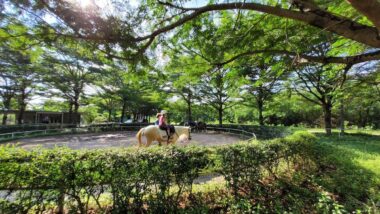How summer travel creates novelty that helps our daughter progress
Learning and development can continue, and even thrive, away from home
Written by |

The clock struck 3:10 in the afternoon, and the bell let out a final scream. I waved goodbye and gave high-fives to eager students. The middle of June marks the end of my academic year as principal and the start of a long break, for which I’ve dedicated several weeks to family time.
Before we learned that our daughter, Rylae-Ann, had aromatic l-amino acid decarboxylase (AADC) deficiency, my wife and I were not much for planning. We preferred spontaneity. As we learned more about Rylae-Ann’s rare disease, however, we understood that having a schedule and planning goals were crucial to her improvement.
A few weeks before our break began, my wife and I were up at night planning our weeks of summer. Trips and activities were centered around three primary goals.
A new experience in developing vocabulary
Traveling to new destinations provides novel experiences. These boost motivation while also providing an enriching learning environment. Changes in place are perfect for exposing children to new vocabulary. When Rylae-Ann was learning to take her first steps, we used to do something similar at the grocery store. Now we get to take the adventures further.
Many other skills go along with traveling. Rylae-Ann is still working on her sensory-processing issues. We hope the change in environment helps her become more adaptable and flexible. We want to foster curiosity and encourage her to explore. A couple of months ago, we started to give her more independence. That goal took a slight detour when she broke her arm. The bone healed, and the cast came off in time for summer break. It’s time for her to get back on track.
As educators, my wife and I know the importance of building vocabulary. An extensive vocabulary supports success in not just speaking, but in all areas of communication. The larger the vocabulary, the greater the academic success and reading ability.

Rylae-Ann and her mom use a trip to the grocery store to build vocabulary and work on speech. (Photo by Richard E. Poulin III)
Using activities to create emotional stability
Recently, our daughter has had outbursts and poor behavior. Thinking back to life before gene therapy, her mischief is a luxury. Yet we continue to take forward steps.
We’re unsure how much her negative actions have to do with the symptoms of AADC deficiency, such as low dopamine and serotonin, since all parents deal with behavior issues in children. At school, I deal with it more than I’d like. However, there seems to be a noticeable difference in how she manages her emotions.
Her outbursts are sudden and impulsive. We plan to use our travel to continue our drama therapy activities. This creative therapy helps children explore and express their emotions in a safe and supportive environment. Travel can assist my wife and me in creating engaging activities to demonstrate positive behavior and model how we deal with problems.
When Rylae-Ann is outside and active, her mood improves. She’s more receptive to feedback, which is necessary for her learning process. Feedback is not yelling or shouting. It shouldn’t prevent learning. Instead, it should be positive and provide specific directions on what students are doing well and how they can do better.
When my wife and I are outdoors, our stress also decreases. We have more motivation and patience. We end up doing more. We’re also able to give better feedback.

Since Rylae-Ann has been able to walk, we’ve used outdoor activities to build her strength through fun activities. (Photo by Richard E. Poulin III)
Traveling to build strength and conditioning
Low muscle tone is another debilitating symptom of AADC deficiency. Since her gene therapy, her muscle mass and physical abilities have substantially increased. Compared with other children her age, though, she’s still not as strong, is less coordinated, and has poor balance. We’ll work as a family during the summer to help change that.
Being outdoors and active is the typical way children develop. Physical therapy doesn’t always have to be in a clinic; it can happen anywhere. Traveling creates the perfect environment to make this happen. My wife included several of our daughter’s favorite activities, including swimming and riding horses. By having familiar activities in new places, we can continue increasing her adaptability and flexibility.

Rylae-Ann’s favorite activity is riding horses, and her parents have scheduled it during her summer break. (Photo by Richard E. Poulin III)
Summer is a time when our family cherishes uninterrupted time together. Consider taking a trip this summer to make memories and progress with your child.
Note: AADC News is strictly a news and information website about the disease. It does not provide medical advice, diagnosis, or treatment. This content is not intended to be a substitute for professional medical advice, diagnosis, or treatment. Always seek the advice of your physician or other qualified health provider with any questions you may have regarding a medical condition. Never disregard professional medical advice or delay in seeking it because of something you have read on this website. The opinions expressed in this column are not those of AADC News or its parent company, Bionews, and are intended to spark discussion about issues pertaining to aromatic l-amino acid decarboxylase deficiency.






Leave a comment
Fill in the required fields to post. Your email address will not be published.